| Millennium: | 2nd millennium |
|---|---|
| Centuries: | |
| Decades: | |
| Years: | |

| 1581 by topic |
|---|
| Arts and science |
| Leaders |
| Birth and death categories |
| Births – Deaths |
| Establishments and disestablishments categories |
| Establishments – Disestablishments |
| Works category |
1581 ( MDLXXXI ) was a common year starting on Sunday in the Julian calendar, and a common year starting on Thursday (link will display full calendar) in the Proleptic Gregorian calendar.










